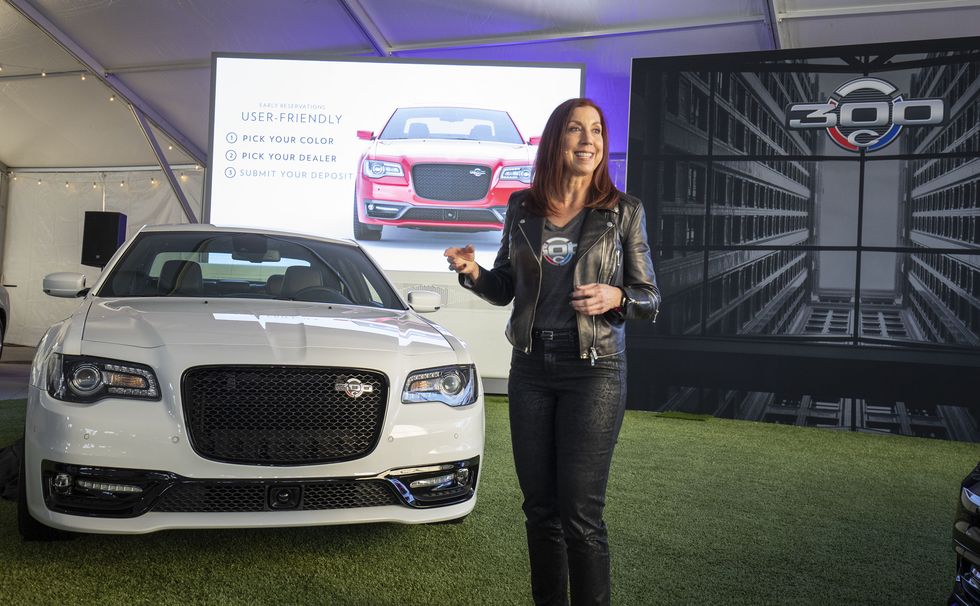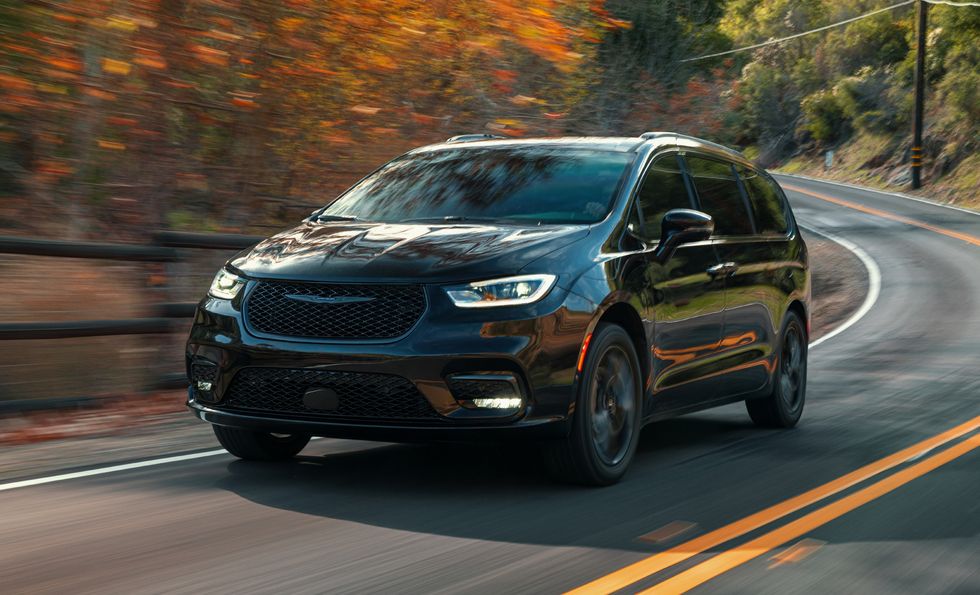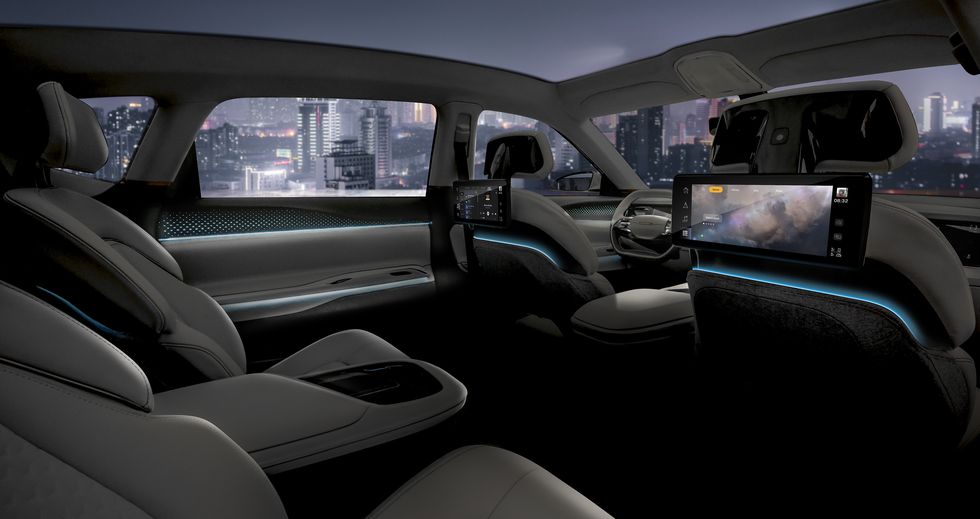- For, Chrysler, which has been starved for new product, the shift to electrification is set to modernize the classic domestic brand.
- With a production-ready model based on the Airflow concept in product testing, Chrysler CEO Christine Feuell says edgy design and increased connectivity will grow its customer base.
- Chrysler’s previous commitment to offering a fully electric portfolio by 2028 and re-working its dealership experience is a major part of that, Feuell says.
At one point in time, Chrysler was a household brand of comfort, familiarity, and even aspiration. These days, the classic brand is hanging by a thread, and that’s not hyperbole. With only one model consistently available (the excellent Pacifica minivan) and the aged-but-fun 300 sedan dying off, its role within the future Stellantis is diminished and in question.
This isn’t exactly surprising, though. The automotive industry struggled in the late 20th century and this weakened manufacturers across the board, but the 21st century has hammered nails into the coffin for some more than others. For Chrysler, that has meant an uphill battle against aging platforms, middling technology, and brand reorganization.
But don’t count Chrysler out just yet. The acceleration of electric-vehicle development and a slow but steady adoption rate is giving brands like Chrysler a second chance. With standardized, skateboard-style chassis and less individual character derived from the powertrain, producing a quality EV is a balance of range, design, and comfort—and Chrysler has teased us with its ability to do just that.
Most recently, Chrysler showed off special editions of its not-in-production Airflow EV concept—at last year’s New York Auto Show. The admittedly handsome Airflow concept was originally revealed in 2020 as a sketch, then in person at the 2022 Consumer Electronics Show, with claims of 400 miles of range, all-wheel drive, and a pair of 150-kW electric motors.
Originally predicted for production on Stellantis’ STLA Medium platform, Chrysler executives say the incoming model based on the Airflow concept is nearly here, and it might actually be on the STLA Large platform.
“What we intend to launch in 2025 is certainly inspired by the Airflow, but not the Airflow in its exact form,” Christine Feuell, Chrysler Brand CEO, explained in an interview with Autoweek at the 2023 New York Auto Show. “We previewed that product to the dealers a couple of weeks ago and took it to research with customers in LA. I can’t give away all of the details, but I will say that it incorporates a lot of what you saw in the Airflow’s design cues.”
Feuell also confirmed the model will be a full-size crossover with slightly shorter dimensions than the original Airflow concept. Additionally, Feuell says consumers can expect another crossover to follow, though she couldn’t confirm its propulsion method. Even so, it’s clear that Chrysler is targeting a market that it has long succeeded in: affordable cars for young, middle-class families.
With a competitively priced minivan in the market, Feuell admitted Chrysler’s main customer demographic is these families, and that holding onto these customers as the brand transitions will be essential. But reconciling this customer base with the company’s plans to be fully electric in 2028 could prove to be even more challenging. Chrysler does have plans to entice young buyers and it involves connectivity, as the brand is claimed to be leading Stellantis’ push into the electrified world.
“If they don’t already own a battery-electric vehicle, they have a very strong intention to purchase one in the near future,” Feuell says. “The idea of incorporating our smart technology that allows them to integrate their personal digital life with their mobile digital life is something that really adds value to them.”
Indeed, Chrysler has touted its incoming technology package as a feature to be respected. The package is called the STLA SmartCockpit and it features a massive center touchscreen, a menu-based format with personalized interior settings, built-in cameras, and certain autonomous capabilities. Will these enhanced versions of widely available features and technologies really persuade buyers?
Chrysler certainly thinks so, but model timing is likely to play a significant role, too. With Ford’s Mustang Mach-E continuing to excel, Hyundai and Kia pumping out a number of well-received EVs, and Polestar recently releasing a model that mirrors the Airflow concept, there is an argument to be made that Chrysler has already missed the ship. Or that the ship is already full of very similar models.
“The shift to EVs is a common tactic for today’s struggling brands. It allows large global automakers to test out electric-vehicle efforts with less risk than committing a successful brand that’s making strong money selling traditional cars,” Karl Brauer, Executive Analyst at iSeeCars.com told Autoweek. “Chrysler’s lack of popularity with consumers is less of an issue with EV consumers because many of them are younger, not brand loyal, and simply interested in the best EV option they can find, regardless of brand or brand history.”
Chrysler executives and Stellantis’ CEO would disagree for many reasons, but especially as a result of the company’s electrification outlook. From Maserati and Ram to Jeep and Fiat, the Stellantis approach to electrification is purposefully gradual, CEO Carlos Tavares says. Tavares also believes that at least 400 miles of range are essential to the success of EVs.
Even so, it’s not particularly surprising that launching the Airflow has been drawn out. If Chrysler is going to truly be the “sustainability pillar” of Stellantis, then launching a capable, semi-affordable, and relatively sustainable EV requires additional investment into battery chemistry, market research, and adherence to evolving government subsidy regulations. Nonetheless, Chrysler’s future is teetering on the successful rollout of the production-ready Airflow model, given that Chrysler’s lineup has been down to three or fewer models since 2012.
“The Chrysler brand has little value in today’s market. It could be eliminated with no real loss to Stellantis’ global reach and long-term finances,” Brauer says. “Using Chrysler as a test bed for EV sales is another option, and one that makes sense for the brand.”
Ultimately, this shift could give Chrysler another life through its product and customer experience. For starters, Chrysler plans to roll out a modern, online ordering process for its upcoming EVs, allowing customers to customize their car and then choose the dealership where it will be delivered. But it will take more than smooth sales processes to save Chrysler.
“Chrysler needs the same thing every brand needs: compelling and competitive models that people want to buy. The brand has been neglected for years, which is why it has increasingly failed to offer those traits,” Brauer explained. “If Stellantis can attach new compelling product to Chrysler—EV or not—the brand can thrive, though it will have to overcome years of lost brand value. Even an incredibly good EV wearing a Chrysler badge will have to work harder, at least initially, to establish a strong and growing customer base.”
Finally, with 14 other brands in the Stellantis portfolio, outsourcing global Airflow production to EV-savvy plants in Europe could maximize the Airflow’s success. Producing it in the US will be critical for domestic affordability under current IRA provisions, but launching the model globally could add needed cash to Chrysler’s bottom line. Perhaps this strategy will be Chrysler’s contribution to Tavares’ claim that Stellantis “will be the only credible challenger to Tesla.”
Meanwhile, other brands are well ahead of Chrysler and Stellantis overall in actually challenging Tesla already.
Do any historic Chrysler models stand out in your memory? Please share your thoughts below.
Associate Editor
A New York transplant hailing from the Pacific Northwest, Emmet White has a passion for anything that goes: cars, bicycles, planes, and motorcycles. After learning to ride at 17, Emmet worked in the motorcycle industry before joining Autoweek in 2022. The woes of alternate side parking have kept his fleet moderate, with a 2014 Volkswagen Jetta GLI and a 2003 Honda Nighthawk 750 street parked in his South Brooklyn community.
Read the full article here






